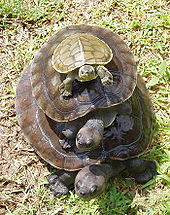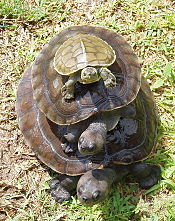Northern river terrapin
| Northern river terrapin | |
|---|---|

| |
| 1878 illustration | |

| |
| Male in breeding colours | |
| Scientific classification | |
| Domain: | Eukaryota |
| Kingdom: | Animalia |
| Phylum: | Chordata |
| Class: | Reptilia |
| Order: | Testudines |
| Suborder: | Cryptodira |
| Superfamily: | Testudinoidea |
| Family: | Geoemydidae |
| Genus: | Batagur |
| Species: | B. baska
|
| Binomial name | |
| Batagur baska | |
| Synonyms[3] | |
|
click to expand
| |
The northern river terrapin (Batagur baska) is a species of riverine turtle native to Southeast Asia. It has been classified as Critically Endangered on the IUCN Red List and considered extinct in much of its former range; as of 2018, the population in the wild was estimated at 100 mature individuals.[1]
Description
[edit]
The northern river terrapin is one of Asia's largest freshwater and brackwater turtles, reaching a carapace length of up to 60 cm and a maximum weight of 18 kg.[4] Its carapace is moderately depressed, with a vertebral keel in juveniles. The plastron is large, strongly angulate laterally in the young, convex in the adult. The head is rather small, with a pointed and upwards-tending snout. The legs have band-like scales.[5]
The upper surface of the carapace and the soft parts are generally olive-brown, while the plastron is yellowish. Head and neck are brown with reddish bases. Males in breeding coloration have a black head and neck with a crimson or orange dorsal surface and red or orange forelegs. The colour of the pupils also changes during this period, to brown in females and yellow-white in males. During the breeding season, the color of the pupils of a female brown whereas the pupils in the males become yellowish-white.[5][6]
Distribution and habitat
[edit]The species is currently found in Bangladesh and India (in the Sunderbans), Cambodia, Myanmar, Indonesia and Malaysia. It is regionally extinct in Singapore, Thailand and Vietnam. It is strongly aquatic but uses terrestrial nesting sites, frequenting the tidal areas of estuaries, large rivers, and mangrove forests.[1]
Ecology
[edit]The northern river terrapin is omnivorous, taking waterside plants and small animals such as clams.[7] The species prefers freshwater habitats and moves to brackish river mouths or estuaries in the breeding season (December–March), returning after laying their eggs. Individuals have been known to undertake long seasonal migrations of 50 to 60 miles to the sand banks where they were hatched. Females usually lay three clutches of 10–34 eggs each.[7][8]
Conservation
[edit]The species is considered Critically Endangered by the IUCN, principally due to exploitation as a food item (including egg harvesting). Previously, immense numbers were shipped into the fish markets of Calcutta from throughout India; among the Bengali Hindus, the river terrapin was considered the most delectable of all turtles.[9] It is still illegally exported from Indonesia and traded in large numbers in China. Loss of nesting beaches and pollution are also impacting the species.[1]
A hatchery and captive breeding project was established in Bhawal National Park in Bangladesh and another in Sajnakhali Wildlife Sanctuary in the Sunderban Tiger Reserve in India with support from Turtle Survival Alliance[9] and Dr. Peter Praschag, the founder of Turtle Island.
After conducting conservation genetics studies on this critically endangered species,[10] Dr. Peter Praschag in collaboration with the Schönbrunn Zoo in Austria, established the only breeding group of this species outside of its native countries.[11] In May 2010, two northern river terrapins successfully hatched at Turtle Island, making this the first-ever captive breeding of Batagur baska worldwide. Further details on Turtle Island’s efforts to rewild this species can be found on their website.
In 2015, Dr. Peter Praschag and the Schönbrunn Zoo expanded their conservation efforts by establishing an additional breeding center for the northern river terrapin in Karamjal, at the edge of the Sundarbans in Bangladesh. This center along with the station at Bhawal National Park has successfully bred and raised juveniles of this species. Prior to the establishment of these centers, in 2005, the global population of B. baska was critically low, with only two known living females at the Madras Crocodile Bank Trust in Tamil Nadu, India. As of 2024, the combined efforts of these centers, have resulted in a thriving population of 565 individuals in these centers and an estimated worldwide population of 800. Additional information on this conservation initiative is available on the Schönbrunn Zoo website.
Taxonomy
[edit]Two subspecies are recognized: B. b. baska (Gray, 1831) and B. b. ranongensis (Nutaphand, 1979).[2]
See also
[edit]References
[edit]- ^ a b c d e Praschag, P.; Singh, S. (2019). "Batagur baska". IUCN Red List of Threatened Species. 2019: e.T97358453A2788691. doi:10.2305/IUCN.UK.2019-1.RLTS.T97358453A2788691.en. Retrieved 18 November 2021.
- ^ a b Rhodin, A. G.J.; van Dijk, P. P.; Inverson, J. B.; Shaffer, H. B.; Roger, B. (2011). "Turtles of the world, 2011 update: Annotated checklist of taxonomy, synonymy, distribution and conservation status" (PDF). Chelonian Research Monographs. 5. Archived (PDF) from the original on 2012-01-31.
- ^ Fritz, U.; Havaš, P. (2007). "Checklist of Chelonians of the World" (PDF). Vertebrate Zoology. 57 (2): 212–213. doi:10.3897/vz.57.e30895. S2CID 87809001. Archived (PDF) from the original on 2011-05-01. Retrieved 29 May 2012.
- ^ "Northern River Terrapin (Batagur baska)". Turtle Survival Alliance (TSA).
- ^ a b Boulenger, G. A. (1890). The Fauna of British India, including Ceylon and Burma: Reptilia and Batrachia. Taylor & Francis.
- ^ "An endangered terrapin". The New Indian Express. Archived from the original on June 1, 2016.
- ^ a b "Batagur baska field guide". Asian Turtle Network.
- ^ "Batagur baska". Arkive.org. Archived from the original on 2015-09-05. Retrieved 2015-09-04.
- ^ a b Moll, E. O.; Kalyar Platt; Platt, S. G.; Praschag, P.; van Dijk, P. P. "Batagur baska : Northern river terrapin" (PDF). Iucn-tftsg.org. Retrieved 2022-03-24.
- ^ Spitzweg, Cäcilia; Praschag, Peter; Diruzzo, Shannon; Fritz, U. (2018). "Conservation genetics of the northern river terrapin (Batagur baska) breeding project using a microsatellite marker system". Salamandra- German Journal of Herpetology. 54: 63–70.
- ^ Weissenbacher, A.; Preininger, D.; Ghosh, R.; Morshed, A. G. J.; Praschag, Peter (2015). "Conservation breeding of the Northern river terrapin Batagur baska at the Vienna Zoo, Austria, and in Bangladesh". International Zoo Yearbook. 49 (1): 31–41. doi:10.1111/izy.12070. ISSN 0074-9664.
Further reading
[edit]- Das, Indraneil (1989). "Batagur baska in Orissya". Hamadryad: The Journal of the Madras Crocodile Bank Trust. 14 (1): 2–3.
- Gray, J.E. (1857). "Notice of some Indian tortoises (including the description of a new species presented to the British Museum by Professor Oldham)". Annals and Magazine of Natural History. 19 (2): 342–344.
External links
[edit]- Centre for Turtle Research and Conservation (archived 19 May 2007)
- Batagur baska at the Reptarium.cz Reptile Database


